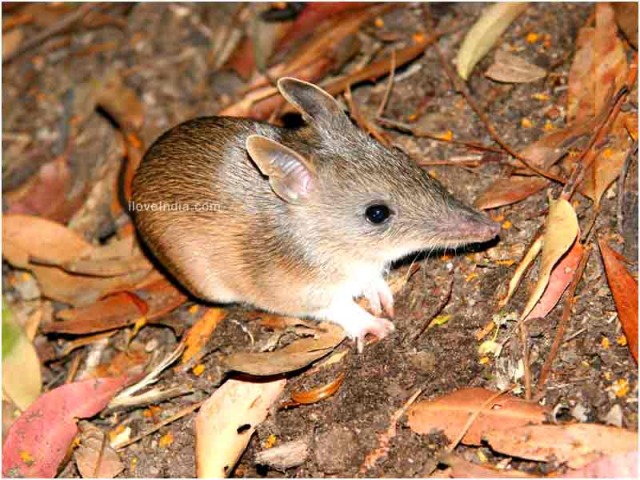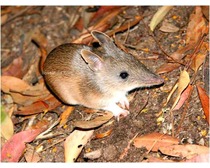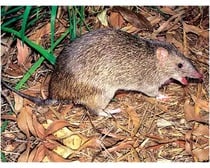Do you want to learn interesting facts about the long nosed bandicoot? If yes, then explore this article and get amazing facts about the animal.
Facts About Long Nosed Bandicoot
A native of Australia, long nosed bandicoot belongs to the family Peramelidae. The animal is scientifically known as Peramelesnasuta and is a species of the bandicoot found in Australia. The animal has pointed ears and a long pointed snout. As compared to the other bandicoots, long nosed bandicoot is much less colorful, having a primarily graying-brown color. These species covered by spiny fur, closely resembles the shape and size of a rabbit. There are only 21 species of bandicoots and out of them 11 species are long nosed, which belong to Australia. According to scientists, there were several varieties of bandicoot species in Australia, but due to climate change, many of the species got extinct over the years. Today, these species are listed as an endangered species threatened by the changing environment and habitat loss. To learn some more interesting and amazing facts about the long nosed bandicoot, browse through the following lines.

Fast Facts
Binomial Name: Peramelesnasuta
Kingdom: Animalia
Phylum: Chordata
Class: Mammalia
Infraclass: Marsupialia
Order: Peramelemorphia
Family: Peramelidae
Genus: Perameles
Species: P. nasuta
Length: 8-17 inches
Weight: 6½ pounds (male weighs more than the female)
Lifespan: 3 years
Range: East coast of Australia
Diet: Insects and other small invertebrates, roots, plants
Habitat: Rainforest, moist gulley, wet and dry woodlands
Age of Sexual Maturity: Males: 5 months, Females: 5 months
Gestation Period: Approx 12 days
Number of Offspring: 1-7, but usually 2-4
Interesting & Amazing Information On Long Nosed Bandicoots
- Long nosed bandicoot looks like a cross between a small kangaroo and a shrew.
- Bandicoots are small mysterious creatures with huge ears, a long pointy nose and a rat-like tail.
- The animal has derived its name from the word Bandictoa, which means pig-rat.
- Long nosed bandicoot has a grayish-brown color on the back, whilst its underside is creamy white as are parts of its feet
- The animal, as compared to others, makes more noise. For instance, if disturbed, it makes a high-pitched call.
- Long nosed bandicoots are nocturnal in nature and dig holes in ground looking for food.
- These rare species are terrestrial and live entirely on land and for this reason any change in the environment or ecological damage can affect these species to a large extent.
- These animals are omnivore marsupial i.e. they feed on both plants and animals. Insects such as lizards, worms, spiders, snails and tubers also form part of their diet.
- Long nosed bandicoots are prey to many animals, including dingoes, snakes, and foxes.
- As with all marsupials, the female long nosed bandicoots have an opening pouch to carry their young.
- The animal digs hole with its paws, but uses its long nose to reach in and gather insects that are hiding or buried.
- Bandicoots are often seen making snuffling sounds while looking for their food. As soon as they find it, they make a loud grunting noise, rather like a piglet.
- The long nosed babies are only 13 mm in length and once they are born, they live inside the pouch of the mother for about 54 days.
- The long nosed bandicoots are the only species that have a gestation period of 12 days, which is the shortest gestation period compared to other mammals.
- These animals also have the highest reproduction rate as the females give birth to two or three babies.
- Long nosed bandicoots have many incisors and like kangaroos, their second and third toes on each foot are merged together.
- These bandicoots are one of the 11 main species among the 21 species of bandicoots. Out of these 11, 3 of the species are now declared extinct and the rest have reduced over the years.


See also
More from iloveindia.com
- Home Remedies | Ayurveda | Vastu | Yoga | Feng Shui | Tattoos | Fitness | Garden | Nutrition | Parenting | Bikes | Cars | Baby Care | Indian Weddings | Festivals | Party ideas | Horoscope 2015 | Pets | Finance | Figures of Speech | Hotels in India : Delhi | Hyderabad | Chennai | Mumbai | Kolkata | Bangalore | Ahmedabad | Jaipur
- Contact Us Careers Disclaimer Privacy Policy Advertise With Us Lifestyle Sitemap Copyright iloveindia.com. All Rights Reserved.


